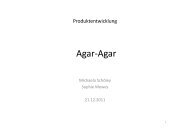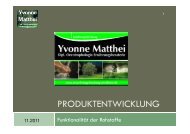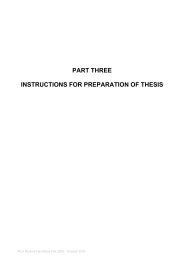Testing GeoDesign in Landscape Planning â First Results
Testing GeoDesign in Landscape Planning â First Results
Testing GeoDesign in Landscape Planning â First Results
Create successful ePaper yourself
Turn your PDF publications into a flip-book with our unique Google optimized e-Paper software.
219<br />
<strong>Test<strong>in</strong>g</strong> <strong>GeoDesign</strong> <strong>in</strong> <strong>Landscape</strong> Plann<strong>in</strong>g –<br />
<strong>First</strong> <strong>Results</strong><br />
Christian ALBERT and Juan Carlos VARGAS-MORENO<br />
1 Introduction<br />
One of the fundamental aspects that is rapidly chang<strong>in</strong>g <strong>in</strong> design and plann<strong>in</strong>g is the<br />
process by which designs are generated and developed (VARGAS-MORENO 2008). In this<br />
context, computer-aided design tools and approaches are <strong>in</strong>troduced that may provide<br />
planners and designers with immediate feedback on the potential impacts of their<br />
propositions, thus potentially enhanc<strong>in</strong>g design processes with real-time <strong>in</strong>formation on<br />
design implications and opportunities for greater <strong>in</strong>volvement of non-experts.<br />
<strong>GeoDesign</strong> is at the epicenter of these discussions. <strong>GeoDesign</strong> is “a design and plann<strong>in</strong>g<br />
method which tightly couples the creation of a design proposal with impact simulations<br />
<strong>in</strong>formed by geographic context” (FLAXMAN 2010a, b). The <strong>GeoDesign</strong> concept has been<br />
proposed and fostered ma<strong>in</strong>ly through a series of <strong>in</strong>ternational conferences organized by<br />
ESRI, the lead<strong>in</strong>g company for GIS software solutions, and has ga<strong>in</strong>ed <strong>in</strong>creas<strong>in</strong>g attention<br />
over the last three years. <strong>GeoDesign</strong> conceptually builds upon the traditional design<br />
approach of sketch<strong>in</strong>g an idea, evaluat<strong>in</strong>g it, and redraw<strong>in</strong>g the design. What makes<br />
contemporary approaches to <strong>GeoDesign</strong> unique however is the exploitation of nowadays<br />
available technology to provide rapid, model-based feedback on different design proposals.<br />
<strong>Landscape</strong> plann<strong>in</strong>g offers a potentially very useful field of application of <strong>GeoDesign</strong>approaches.<br />
<strong>Landscape</strong> planners often use scenarios as a basis for simulat<strong>in</strong>g and assess<strong>in</strong>g<br />
possible future landscape configurations (alternative futures). A <strong>GeoDesign</strong> approach to<br />
landscape plann<strong>in</strong>g would enable planners to much more rapidly develop, alter and evaluate<br />
alternative futures. This could ease the participation of affected and <strong>in</strong>terested parties <strong>in</strong> the<br />
plann<strong>in</strong>g process.<br />
Research gaps exist on the one hand concern<strong>in</strong>g the practical implementation of the<br />
<strong>GeoDesign</strong>-approach <strong>in</strong> landscape plann<strong>in</strong>g. On the other hand, the potentials and<br />
limitations of provid<strong>in</strong>g rapid, model<strong>in</strong>g-based feedback <strong>in</strong> participatory plann<strong>in</strong>g processes<br />
have not been thoroughly explored.<br />
2 Research Objective and Methods<br />
As a first steps towards explor<strong>in</strong>g the usefulness of a <strong>GeoDesign</strong>-approach <strong>in</strong> landscape<br />
plann<strong>in</strong>g practice, one objective of this contribution is to explore how <strong>GeoDesign</strong> can be<br />
implemented <strong>in</strong> landscape plann<strong>in</strong>g with<strong>in</strong> the ArcGIS software environment. Another<br />
objective is to discuss the opportunities and limitations of the currently available tools for<br />
us<strong>in</strong>g a <strong>GeoDesign</strong> approach to landscape plann<strong>in</strong>g <strong>in</strong> practice.
220<br />
C. Albert and J. C. Vargas-Moreno<br />
The research questions are:<br />
1. Which steps does a <strong>GeoDesign</strong> process consist of and which tools for implement<strong>in</strong>g<br />
them are already available <strong>in</strong> ArcGIS 10?<br />
2. How can the identified <strong>GeoDesign</strong> tools be used to support landscape plann<strong>in</strong>g?<br />
3. Which opportunities and limitations do current tools exhibit for application <strong>in</strong> plann<strong>in</strong>g<br />
practice?<br />
Questions two and three will be explored on the basis of an exemplary test <strong>in</strong> a plann<strong>in</strong>g<br />
study for the region of Hanover, Germany. The region was selected due to the availability<br />
of detailed spatial data and the diversity of site conditions. The plann<strong>in</strong>g process focuses on<br />
the development of two scenarios of future landscape development, and exemplary<br />
evaluates their respective impacts on biodiversity. The two scenarios are understood as<br />
extreme options for landscape development that are both unlikely to occur as proposed, but<br />
nevertheless frame the development corridor with<strong>in</strong> which landscape change will probably<br />
take place.<br />
The research methods can be sorted to three parts: <strong>First</strong>, available literature and onl<strong>in</strong>e<br />
resources are reviewed. This section results <strong>in</strong> the development of a framework of essential<br />
components of a Geo-Design process. Then, publications and onl<strong>in</strong>e resources are used to<br />
identify tools and extensions currently available for ESRI’s ArcGIS 10 for conduct<strong>in</strong>g these<br />
steps. The identified tools and extensions are then mapped to the components of a<br />
<strong>GeoDesign</strong> framework, result<strong>in</strong>g <strong>in</strong> an overview of available methods for each step.<br />
Afterwards, the <strong>GeoDesign</strong> tools are applied <strong>in</strong> the landscape plann<strong>in</strong>g case study. The<br />
plann<strong>in</strong>g process consists of five steps:<br />
1. Develop<strong>in</strong>g a conceptual model for assess<strong>in</strong>g biodiversity<br />
2. Translat<strong>in</strong>g the conceptual model <strong>in</strong>to the model builder<br />
3. Def<strong>in</strong><strong>in</strong>g and simulat<strong>in</strong>g two extreme scenarios for landscape development<br />
4. Assess<strong>in</strong>g and report<strong>in</strong>g the impacts of the two scenarios on biodiversity<br />
F<strong>in</strong>ally, they application of the tools is critically discussed concern<strong>in</strong>g its opportunities and<br />
limitations.<br />
It is important to emphasize that the here<strong>in</strong> described study is only a first step for test<strong>in</strong>g<br />
and evaluat<strong>in</strong>g the usefulness of a <strong>GeoDesign</strong> approach to landscape plann<strong>in</strong>g. More<br />
sophisticated simulations of land use changes <strong>in</strong> each scenario, as well as more elaborated<br />
and evidence-based assessment methods for evaluat<strong>in</strong>g biodiversity and other landscape<br />
functions would be needed <strong>in</strong> real plann<strong>in</strong>g applications. The case study therefore only<br />
presents prelim<strong>in</strong>ary results on opportunities and limitations of the use of contemporary<br />
<strong>GeoDesign</strong> tools <strong>in</strong> landscape plann<strong>in</strong>g, based on a critical evaluation from the planners’<br />
perspective.<br />
3 <strong>Results</strong><br />
3.1 Basic components of <strong>GeoDesign</strong><br />
Interest<strong>in</strong>gly, a search on the ISI web of science for the term “geodesign” as the topic or<br />
title reveals only two references, of which one is a two-page Croatian article from 2011,<br />
and the other an Austrian article from 1994. Therefore, the follow<strong>in</strong>g review is based on<br />
other peer-reviewed publications, <strong>in</strong> particular DANGERMOND (2010) and FLAXMAN
<strong>Test<strong>in</strong>g</strong> <strong>GeoDesign</strong> <strong>in</strong> <strong>Landscape</strong> Plann<strong>in</strong>g – <strong>First</strong> <strong>Results</strong> 221<br />
(2010a) as well as grey literature (<strong>in</strong>clud<strong>in</strong>g ABUKHATER & WALKER 2010, DANGERMOND<br />
2009, VARGAS MORENO 2010). Taken together, the literature argues that <strong>GeoDesign</strong><br />
process <strong>in</strong>cludes at least the follow<strong>in</strong>g three components:<br />
The <strong>in</strong>put process (a.k.a the design): A sketch<strong>in</strong>g <strong>in</strong>terface that allows for rapid<br />
generation of alternative designs consist<strong>in</strong>g of spatial features with attributes <strong>in</strong> a<br />
geographic context.<br />
The evaluation (a.k.a the impact): A set of spatially <strong>in</strong>formed models that assess the<br />
potential impacts of an entered design based on a series of evaluation parameters, and<br />
The result: ( a.k.a the report): The <strong>in</strong>strument that communicates the outcomes of the<br />
impact evaluations <strong>in</strong> rapid, predeterm<strong>in</strong>ed and understandable ways. The fast feedback<br />
then serves as <strong>in</strong>put for another iterative cycle of sketch<strong>in</strong>g and evaluation.<br />
3.2 Tools and methods for implement<strong>in</strong>g <strong>GeoDesign</strong> with ArcGIS 10<br />
The review of publications on the ArcGIS 10 software package (e.g. ALLEN 2011, HARDER<br />
et al. 2011, ORMSBY et al. 2010) shows that no comprehensive documentation is so far<br />
available of which tools can be used for implement<strong>in</strong>g the entire <strong>GeoDesign</strong> process <strong>in</strong> a<br />
plann<strong>in</strong>g project.<br />
The currently available methods for <strong>GeoDesign</strong> with ArcGIS 10 are summarized <strong>in</strong> table 1.<br />
For each component of the <strong>GeoDesign</strong> workflow, some tools are already existent. Other<br />
f<strong>in</strong>d<strong>in</strong>gs <strong>in</strong>clude:<br />
Sketch<strong>in</strong>g is implemented by a new feature of ArcGIS that was formerly known as the<br />
ArcSketch extension (but requires some level of customization).<br />
A useful approach for conduct<strong>in</strong>g rapid impact evaluations is to create a (simple)<br />
impact evaluation model <strong>in</strong> the model builder and def<strong>in</strong><strong>in</strong>g it as a new tool. This tool is<br />
then readily available for impact evaluations. When started, it will prompt for the <strong>in</strong>put<br />
layer to use, and then conduct the analysis.<br />
Report<strong>in</strong>g the results of the rapid impact evaluations can be accomplished <strong>in</strong> three<br />
ways: the display of the maps created by the impact models, tables that summarize the<br />
spatial extend of areas that fulfill specific criteria, and diagrams. In addition, a new<br />
ESRI prototype, called dynamic chart<strong>in</strong>g, has been recently released for rapidly<br />
creat<strong>in</strong>g and dynamically updat<strong>in</strong>g charts that summarize a given field of a data source<br />
(e.g. costs or area). A significant issue identified is the restriction to move from reports<br />
back to design or evaluation seek<strong>in</strong>g iterative improvements. Other constra<strong>in</strong>ts will be<br />
discussed <strong>in</strong> full manuscript.<br />
Component I:<br />
Sketch<strong>in</strong>g<br />
Editable templates for<br />
ArcMap s <strong>in</strong>cluded <strong>in</strong><br />
ma<strong>in</strong>stream ArcGIS 10<br />
(formerly the ArcSketch<br />
extension)<br />
Component II:<br />
Impact evaluation<br />
Creat<strong>in</strong>g an impact<br />
evaluation model <strong>in</strong><br />
model builder<br />
Component III:<br />
Report<strong>in</strong>g<br />
Display<strong>in</strong>g maps that<br />
result from impact<br />
evaluation model<strong>in</strong>g<br />
Display<strong>in</strong>g tables and<br />
charts that summarize<br />
the results<br />
Table 1: Method components and tools for Geodesign currently available <strong>in</strong> ArcGIS 10
222<br />
C. Albert and J. C. Vargas-Moreno<br />
Taken together, the review has shown that tools already exist <strong>in</strong> ArcGIS to fulfil the core<br />
ideas of <strong>GeoDesign</strong>, but all require substantial customization or advanced knowledge of the<br />
software platform.<br />
3.2 Test of the tools <strong>in</strong> the case study region<br />
The region of Hanover has been established <strong>in</strong> 2001 <strong>in</strong> a unification of the former<br />
communities of the city and the surround<strong>in</strong>g county of Hanover. Hanover region<br />
encompasses about 230,000 hectares and is home to about 1.13 Million <strong>in</strong>habitants. The<br />
region is at the transition between the North-German pla<strong>in</strong> and the low mounta<strong>in</strong> ranges of<br />
central Germany. The northern part of the region is a typical moor geest landscape<br />
dom<strong>in</strong>ated by moor or sandy soils, p<strong>in</strong>e forests, grasslands and fields. The southern part of<br />
the region <strong>in</strong>cludes the fertile soils of the Hildesheimer Börde and parts of the Deister<br />
mounta<strong>in</strong> range. The Le<strong>in</strong>e is the ma<strong>in</strong> river, trespass<strong>in</strong>g the region from south to north.<br />
The land use data for the case study is derived from a detailed land use map based on CIR<br />
<strong>in</strong>terpretation of aerial imagery. In order to make the land use map manageable, the<br />
orig<strong>in</strong>ally large number of land use classes was synthesized <strong>in</strong>to ten land use types.<br />
3.2.1 Conceptual model for assess<strong>in</strong>g biodiversity<br />
The literature shows various model<strong>in</strong>g approaches for assess<strong>in</strong>g biodiversity. For example,<br />
WALDHARD et al. (2004) developed a model that estimates and predicts plant species<br />
richness at the local to regional scale based on an empirical assessment. This study uses an<br />
approach proposed by von DRACHENFELS (2004) that employs the importance of biotope<br />
types for nature conservation as a proxy for biodiversity. Each biotope type is evaluated on<br />
a five po<strong>in</strong>t scale with reference to the situation <strong>in</strong> the state of Lower Saxony. Four<br />
evaluation criteria are used: (i) ‘closeness to natural conditions’, (ii) endangerment, (ii)<br />
rareness, and (iv) importance as habitats for plant and animal species. In order to make the<br />
von Drachenfels-method applicable to the land use maps of the case study, a raster scheme<br />
needed to be derived that connected the ten land use types with the respective value for<br />
biodiversity (see table 2).<br />
Land use type<br />
Biodiversity value<br />
Moor 5 Very high importance<br />
Grassland 4 High importance<br />
Forest 3 Medium importance<br />
Moor (degenerated) 3 Medium importance<br />
Fields 2 Low importance<br />
Grassland (<strong>in</strong>tensively used) 2 Low importance<br />
Infrastructure 0 Not evaluated<br />
Settlement area 0 Not evaluated<br />
Waters 0 Not evaluated<br />
Other land uses 0 Not evaluated<br />
Table 2: Evaluation table of land use types and respective biodiversity value<br />
(summarizedand altered from DRACHENFELS (2004))
<strong>Test<strong>in</strong>g</strong> <strong>GeoDesign</strong> <strong>in</strong> <strong>Landscape</strong> Plann<strong>in</strong>g – <strong>First</strong> <strong>Results</strong> 223<br />
3.2.2 Translation of the conceptual model <strong>in</strong>to the model builder<br />
The ArcGIS model builder is used to develop a model for evaluat<strong>in</strong>g biodiversity (see<br />
figure 1) accord<strong>in</strong>g to the evaluation rules def<strong>in</strong>ed <strong>in</strong> section 3.2.1. Input data for the<br />
evaluation of scenario impacts on biodiversity <strong>in</strong>clude (i) a shapefile with the land use<br />
configuration of the alternative future to be evaluated, (ii) an evaluation table (see table 1),<br />
and (iii) a symbology layer that def<strong>in</strong>es the color code for illustrat<strong>in</strong>g the five levels of<br />
importance for biodiversity.<br />
Fig. 1:<br />
Model structure for evaluat<strong>in</strong>g biodiversity<br />
The developed model first jo<strong>in</strong>s the evaluation table with the attribute table of the<br />
alternative future land use map. Then, each feature <strong>in</strong> the shapefile will be attributed a<br />
biodiversity value accord<strong>in</strong>g to the respective land use. The symbology is altered to no<br />
longer refer to the land use, but to the biodiversity value of each feature. In addition, a table<br />
is created that lists the area attributed to each level of importance. Fields <strong>in</strong> figure 1 that are<br />
<strong>in</strong>dicated with a ‘P’ need to be checked and potentially altered by the user <strong>in</strong> each cycle,<br />
<strong>in</strong>clud<strong>in</strong>g the <strong>in</strong>put files and the names and folders for the created files to be saved.<br />
3.2.3 Def<strong>in</strong>ition and simulation of two extreme scenarios<br />
Two scenarios are developed <strong>in</strong> the case study. The first scenario is termed “Bioenergy”<br />
and assumes that the production of biomass for bioenergy is strongly <strong>in</strong>creased. The second<br />
scenario, “Climate mitigation”, assumes that all arable land on organic and alluvial soils<br />
(moor and floodpla<strong>in</strong>s) is converted to grasslands (Table 3).
224<br />
C. Albert and J. C. Vargas-Moreno<br />
Land uses type <strong>in</strong><br />
scenario “Status quo”<br />
Land use type <strong>in</strong> scenario<br />
“Bioenergy”<br />
Grassland Fields Grassland<br />
Fields (on organic and Fields<br />
Grassland<br />
alluvial soils)<br />
Fields (all other areas) Fields Fields<br />
Table 3: Transition rules for the two scenarios to create alternative futures<br />
Land use type <strong>in</strong> scenario<br />
“Climate mitigation”<br />
The simulation of land use changes <strong>in</strong> each scenario followed the transition rules listed <strong>in</strong><br />
table 3. Plots of land were selected that fulfilled the land use type criterion, or the<br />
comb<strong>in</strong>ation of land use type and soils criteria. The attributes of the selected plots were<br />
subsequently changed to represent the land use type of the respective scenario.<br />
3.2.4 Assessment and report of impacts of the two scenarios on biodiversity<br />
To assess the impacts of the two scenarios, the respective alternative futures were used as<br />
<strong>in</strong>put for the developed models <strong>in</strong> the ArcGIS model builder environment. The result<strong>in</strong>g<br />
evaluation maps were color coded for the respective importance of each polygon on the 1 to<br />
five scale. Furthermore, the respective distribution of areas for each level of importance<br />
was summarized <strong>in</strong> a table, and illustrated <strong>in</strong> a bar chart for comparison (figure 2).<br />
Fig. 2:<br />
Simulated land use changes as well as impact evaluation maps and reports
<strong>Test<strong>in</strong>g</strong> <strong>GeoDesign</strong> <strong>in</strong> <strong>Landscape</strong> Plann<strong>in</strong>g – <strong>First</strong> <strong>Results</strong> 225<br />
4 Discussion and Conclusions<br />
The here<strong>in</strong> described study used a limited land use data set of only ten classes, two extreme<br />
scenarios, and only a simple impact evaluation model. The results therefore should not be<br />
understood as detailed recommendations for plann<strong>in</strong>g, but rather as stylized study examples<br />
for test<strong>in</strong>g a procedure for implement<strong>in</strong>g <strong>GeoDesign</strong> <strong>in</strong> landscape plann<strong>in</strong>g.<br />
The study has shown a few opportunities and limitations. The follow<strong>in</strong>g opportunities were<br />
identified:<br />
Transferr<strong>in</strong>g the impact evaluation concept <strong>in</strong>to a model <strong>in</strong> the ArcGIS model builder<br />
was possible. The model builder environment allowed for detailed customization of the<br />
model to the specific plann<strong>in</strong>g needs. Developed models can be saved and used to<br />
evaluate different land use maps that follow a pre-def<strong>in</strong>ed land use cod<strong>in</strong>g.<br />
Translat<strong>in</strong>g the simple land use conversion rules of the scenarios <strong>in</strong>to GIS was easily<br />
doable us<strong>in</strong>g simple feature selection and attribute change commands.<br />
Limitations that became apparent relate ma<strong>in</strong>ly to the question of how useful the developed<br />
<strong>GeoDesign</strong> procedure would be <strong>in</strong> landscape plann<strong>in</strong>g practice:<br />
Customizations of models <strong>in</strong> the model builder can often not be conducted with<strong>in</strong> a<br />
participatory plann<strong>in</strong>g session. Chang<strong>in</strong>g and pre-test<strong>in</strong>g of models requires advanced<br />
knowledge and may take quite some time.<br />
While execut<strong>in</strong>g the evaluation model <strong>in</strong> the case study was possible with<strong>in</strong> a few<br />
seconds, a test with a more complex model showed that the model<strong>in</strong>g time can strongly<br />
<strong>in</strong>crease to about two or more m<strong>in</strong>utes. Studies that employ large datasets and/or<br />
complex models should therefore consider us<strong>in</strong>g distributed comput<strong>in</strong>g power <strong>in</strong> the<br />
cloud.<br />
The need for tools to <strong>in</strong>tuitively respond to the design-evaluation process <strong>in</strong> iterative<br />
ways has not yet been resolved. However, some discussions has started direct<strong>in</strong>g the<br />
characteristics of such systems (LEE 2010, VARGAS MORENO 2010).<br />
Most importantly, what is needed what is a way to develop a front-end appearance for<br />
ArcGIS that comb<strong>in</strong>es the sketch<strong>in</strong>g, impact evaluation and report<strong>in</strong>g components <strong>in</strong> a<br />
common <strong>in</strong>terface that is <strong>in</strong>tuitively usable for diverse audiences. This front-end<br />
appearance should be web-based to provide access also to users that do not have access<br />
to comput<strong>in</strong>g power and the ArcGIS software.<br />
Issues for further research <strong>in</strong>clude (a) further develop<strong>in</strong>g the scenarios and models and<br />
add<strong>in</strong>g additional impact evaluation models, (b) test<strong>in</strong>g the approach with real stakeholders,<br />
(c) <strong>in</strong>vestigat<strong>in</strong>g the reactions and effects of the use of the <strong>GeoDesign</strong> approach <strong>in</strong> a<br />
participatory plann<strong>in</strong>g process on participants’ perceptions and decision mak<strong>in</strong>g (do they<br />
f<strong>in</strong>d it useful?), (d) further develop<strong>in</strong>g the software <strong>in</strong>terface for non-experts, and (e)<br />
develop<strong>in</strong>g and evaluat<strong>in</strong>g options for transferr<strong>in</strong>g a front-end version of the <strong>GeoDesign</strong><br />
plann<strong>in</strong>g process to the web.<br />
5 Acknowledgements<br />
The authors thank Johannes Hermes, Svenja Heitkämper, Rebekka Hofmann, Christiane<br />
Hörmeyer, Angelika Lischka, Felix Neuendorf, and Pia Wedell for support <strong>in</strong> conduct<strong>in</strong>g<br />
the analyses <strong>in</strong> the case study. Johannes Hermes also helped prepar<strong>in</strong>g the graphics. The
226<br />
C. Albert and J. C. Vargas-Moreno<br />
study is related to the research project “Susta<strong>in</strong>able use of bioenergy: bridg<strong>in</strong>g climate<br />
protection, nature conservation and society”, lead by the Interdiscipl<strong>in</strong>ary Centre for<br />
Susta<strong>in</strong>able Development at Georg-August-Universität Gött<strong>in</strong>gen and, <strong>in</strong> part, the Institute<br />
of Environmental Plann<strong>in</strong>g at Leibniz Universität Hannover.<br />
References<br />
Abukhater, A. & Walker, D. (2010), Mak<strong>in</strong>g Smart Growth Smarter with <strong>GeoDesign</strong>. In:<br />
Directions Magaz<strong>in</strong>e, July 19.<br />
Allen, D. W. (2011), Gett<strong>in</strong>g to Know ArcGIS ModelBuilder. Redlands, CA, ESRI Press.<br />
Dangermond, J. (2009), GIS: Design<strong>in</strong>g Our Future. In: ArcNews, Summer issue.<br />
Dangermond, J. (2010), <strong>GeoDesign</strong> and GIS – Design<strong>in</strong>g our Futures. In: Buhmann, E.,<br />
Pietsch, M. & Kretzler, E. (Eds.), Digital <strong>Landscape</strong> Architecture 2010 at Anhalt University<br />
of Applied Sciences. Berl<strong>in</strong>/Offenbach, Wichmann, 502-514.<br />
Flaxman, M., (2010a), Fundamentals of <strong>GeoDesign</strong>. In: Buhmann, E., Pietsch, M. &<br />
Kretzler, E. (Eds.), Peer Reviewed Proceed<strong>in</strong>gs of Digital <strong>Landscape</strong> Architecture 2010<br />
at Anhalt University of Applied Sciences. Berl<strong>in</strong>/Offenbach, Wichmann, 28-41.<br />
Flaxman, M. (2010b), Geodesign: Fundamentals and Routes Forward. Presentation to the<br />
Geodesign Summit, January 6, 2010, Redlands, CA.<br />
Harder, C., Orsmby, T. & Balstrom, T. (2011), Understand<strong>in</strong>g GIS: An ArcGIS Project<br />
Workbook. Redlands, CA, ESRI Press.<br />
Lee, B. (2010), <strong>GeoDesign</strong> <strong>in</strong> Land-Use Plann<strong>in</strong>g. Presentation to the Geodesign Summit,<br />
January 6, 2010, Redlands, CA.<br />
Ormsby, T., Napoleon, E. J. & Burke, R. (2010), Gett<strong>in</strong>g to Know ArcGIS Desktop. ESRI<br />
Press, Redlands, CA.<br />
Vargas-Moreno, J. C. (2008), Participatory landscape plann<strong>in</strong>g us<strong>in</strong>g portable geospatial<br />
<strong>in</strong>formation systems and technologies: the case of the Osa region of Costa Rica. In:<br />
Graduate School of Design, Harvard University, Cambridge, MA, USA.<br />
Vargas-Moreno, J. C. (2010), <strong>GeoDesign</strong>: The Emergence of a Tight-coupl<strong>in</strong>g Approach <strong>in</strong><br />
GIS and Spatial Plann<strong>in</strong>g. In: Plann<strong>in</strong>g & Technology Today.<br />
Von Drachenfels, O. (2004), Kartierschlüssel für Biotoptypen <strong>in</strong> Niedersachsen. Unter<br />
besonderer Berücksichtigung der nach § 28a und § 28b NNatG geschützten Biotope<br />
sowie der Lebensraumtypen von Anhang I der FFH-Richtl<strong>in</strong>ie. Niedersächsisches<br />
Landesamt für Ökologie, Abt. Naturschutz, Hildesheim, 240.<br />
Waldhardt, R., Simmer<strong>in</strong>g, D. & Otte, A. (2004), Estimation and prediction of plant<br />
species richness <strong>in</strong> a mosaic landscape. In: <strong>Landscape</strong> Ecology, 19 (2), 211-226.


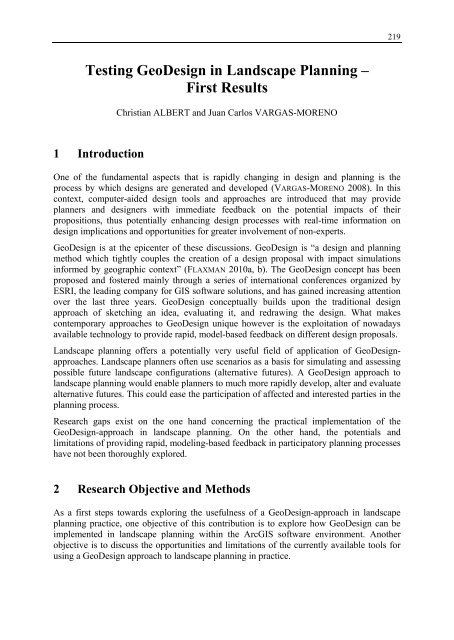

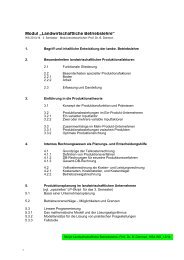
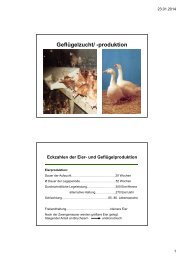
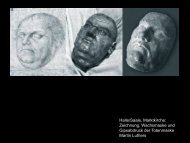
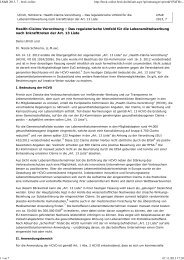
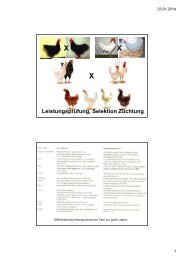
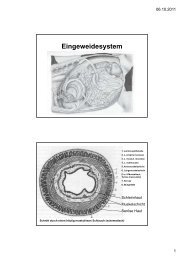
![VL Produktentwicklung Bsp. Hydrokolloide [Kompatibilitätsmodus]](https://img.yumpu.com/23911080/1/184x260/vl-produktentwicklung-bsp-hydrokolloide-kompatibilitatsmodus.jpg?quality=85)
